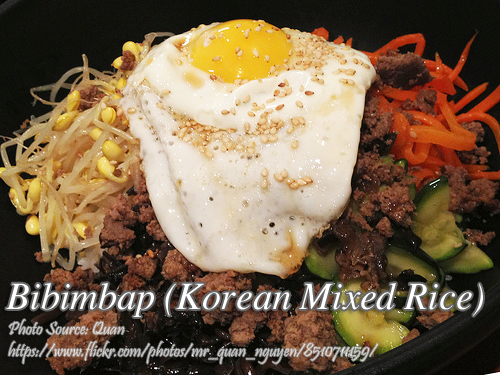How to Make Bibimbap (Korean Mixed Rice)
Bibimbap is a vibrant and flavorful Korean dish that features a harmonious mix of rice, seasoned vegetables, marinated meat, and a spicy-sweet sauce, all topped with a fried egg.
Servings: 2 Servings
Calories: 560kcal
Ingredients
For the ground beef:
- 1/4 kilo ground beef
- 1 1/2 Tbsp. soy sauce
- 1 1/2 Tbsp. garlic minced
- 1 tsp. ground black pepper
- 1 tsp. sugar
For the bean sprouts:
- 100 grams beansprouts toge
- salt to taste
- 1/2 tsp. sesame oil
- 1 Tbsp. garlic minced
For the spinach:
- a bunch of spinach
- salt to taste
- 1/2 tsp. sesame oil
- 1 Tbsp. garlic minced
- 1/2 Tbsp. soy sauce
For the shiitake mushrooms:
- 6 shiitake mushrooms dried or fresh
- 1/2 tsp. sesame oil
- 1 tsp. sugar
- 1/2 Tbsp. soy sauce
Bibimbap sauce:
- 4 Tbsp. Korean red chili pepper paste
- 1 Tbsp. sugar
- 1 Tbsp. sesame oil
- 3 Tbsp. water
The rest of the ingredients:
- 3 cups cooked rice
- 2 small size of zucchinis thinly sliced crosswise
- 1 small carrot julienne into small strips
- 1/4 cup kimchi optional
- 2 eggs fried sunny side up
- 1 tbsp sesame seeds toasted
- vegetable oil
- spring onions for garnish
Instructions
How to cook Bibimbap:
- Combine and mix ground beef, soy sauce, garlic, ground pepper and sugar. Marinate for 20 minutes. In a heated pan with 1 Tbsp. cooking oil, saute the beef mixture in a high heat for 2 to 3 minutes.
- If you are using dried shiitake mushrooms, soaked it first in hot water for a few hours before starting to make this dish. For fresh mushrooms, just wash it then slice thinly. Then saute and add soy sauce, sesame oil, sugar and stir for 2 minutes.
- Soak, wash and clean bean sprouts by removing the husk. Drain and blanch the sprouts. Season with salt, minced garlic and sesame oil. Set aside.
- Blanch the spinach for 1 minute. Then rinse in cold water and squeeze gently to remove excess water. Season with salt, soy sauce, sesame oil and minced garlic. Set aside.
- Then saute the zucchinis in high heat with some cooking oil. Saute until transparent. Set aside.
- Saute the carrots in a lightly oiled pan over high heat for 1 to 2 minutes. Season with salt and pepper to taste. Set aside.
- Combine the bibimbap sauce ingredients in a small bowl. Mix thoroughly until smooth.
- If you want to have a sizzling bibimbap like the one you see in Mr. Kimbob, you can use a round deep sizzling plate.
- Bush the inside of the plate with sesame oil and heat over the stove until a wisp of smoke appears.
- Mold a cup of rice and place in the center of the plate. Then nicely arrange a small amount of each prepared vegetables (bean sprouts, zucchinis, carrots, mushrooms, kimchi) and beef around the rice. Just like what you see on Mr. Kimbob.
- Then top with fried egg and garnish with spring onions. Serve with bibimbap sauce.
